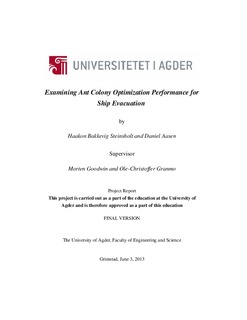| dc.contributor.author | Steinsholt, Haakon Bakkevig | |
| dc.contributor.author | Aasen, Daniel | |
| dc.date.accessioned | 2013-09-24T11:44:39Z | |
| dc.date.available | 2013-09-24T11:44:39Z | |
| dc.date.issued | 2013 | |
| dc.identifier.uri | http://hdl.handle.net/11250/137590 | |
| dc.description | Masteroppgave i informasjons- og kommunikasjonsteknologi IKT590 2013 – Universitetet i Agder, Grimstad | no_NO |
| dc.description.abstract | Evacuating passengers during a fire on board ships is a difficult task and any
improvements on current procedures can help save lives. This report describes
how an Ant Colony Optimization (ACO) pathfinding algorithm could possibly be
used to lead passengers out of this dangerous situation. The ships were modeled
from blueprints of real ships and represented as graphs with nodes and vertices.
In the simulation passengers were equipped with a smart phone running an application
which showed them the way out. The passengers could end up panicking
given close proximity to fire or other stressing factors, in which case they would
stop following directions. Additionally, high density of passengers in rooms and
corridors slowed down the speed of evacuation. The results produced by ACO
were compared to Dijkstra’s pathfinding algorithm and were promising. They
showed that ACO performed well in dynamic environments and could be used in
a crisis situation to guide people out of danger. | no_NO |
| dc.language.iso | eng | no_NO |
| dc.publisher | Universitetet i Agder / University of Agder | no_NO |
| dc.title | Examining ant colony optimization performance for ship evacuation | no_NO |
| dc.type | Master thesis | no_NO |
| dc.source.pagenumber | 44 s. | no_NO |
